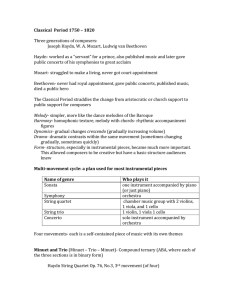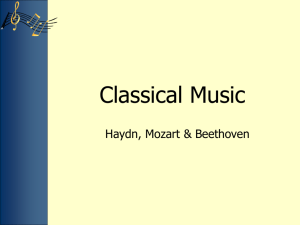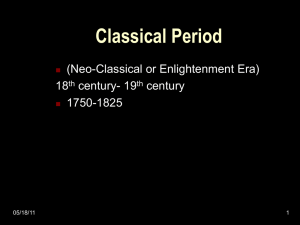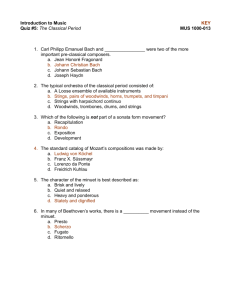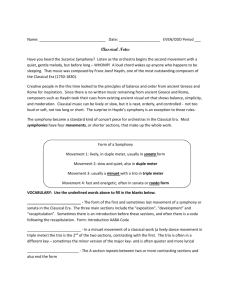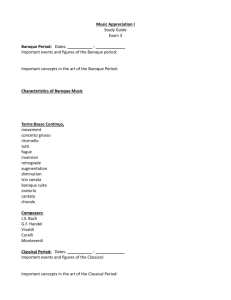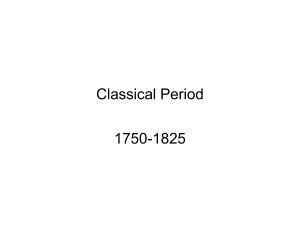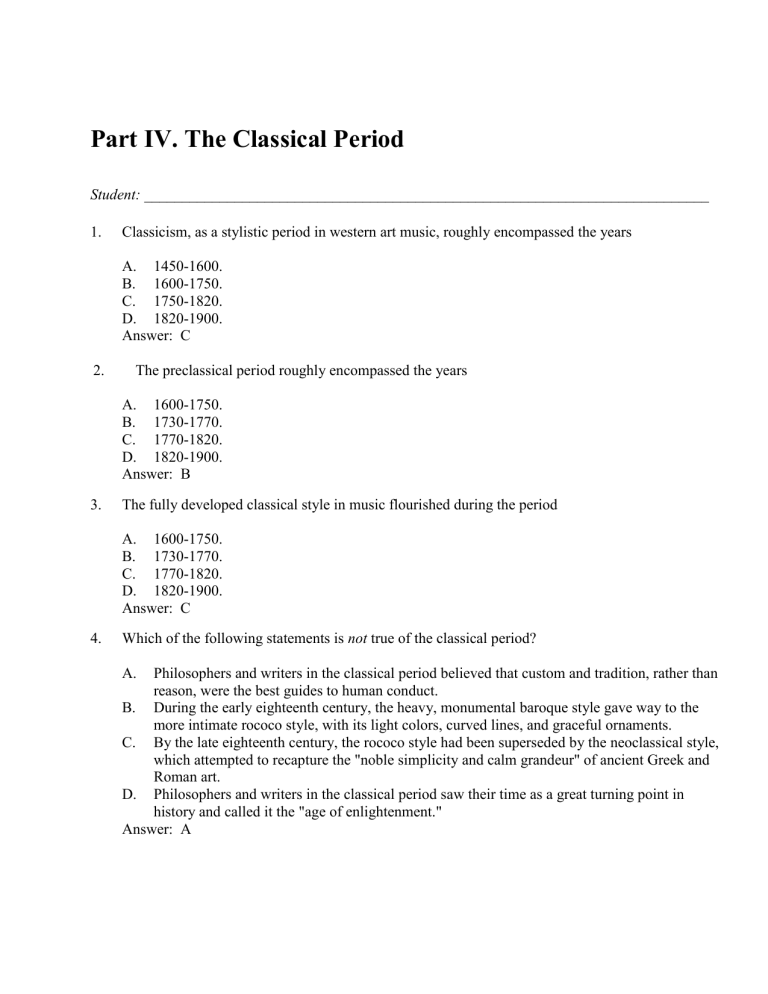
Part IV. The Classical Period Student: ___________________________________________________________________________ 1. Classicism, as a stylistic period in western art music, roughly encompassed the years A. 1450-1600. B. 1600-1750. C. 1750-1820. D. 1820-1900. Answer: C 2. The preclassical period roughly encompassed the years A. 1600-1750. B. 1730-1770. C. 1770-1820. D. 1820-1900. Answer: B 3. The fully developed classical style in music flourished during the period A. 1600-1750. B. 1730-1770. C. 1770-1820. D. 1820-1900. Answer: C 4. Which of the following statements is not true of the classical period? A. Philosophers and writers in the classical period believed that custom and tradition, rather than reason, were the best guides to human conduct. B. During the early eighteenth century, the heavy, monumental baroque style gave way to the more intimate rococo style, with its light colors, curved lines, and graceful ornaments. C. By the late eighteenth century, the rococo style had been superseded by the neoclassical style, which attempted to recapture the "noble simplicity and calm grandeur" of ancient Greek and Roman art. D. Philosophers and writers in the classical period saw their time as a great turning point in history and called it the "age of enlightenment." Answer: A 5. Carl Philipp Emanuel Bach and _____ were two of the more important preclassical composers. A. Jean Honoré Fragonard B. Johann Christian Bach C. Johann Sebastian Bach D. Joseph Haydn Answer: B 6. Which of the following composers is not considered a master of the classical period? A. Johann Christian Bach B. Ludwig van Beethoven C. Wolfgang A. Mozart D. Joseph Haydn Answer: A 7. Which of the following statements is not true? A. B. In the classical period, composers were influenced by folk and popular music. While a late baroque musical composition may convey a single emotion, a classical composition will fluctuate in mood. C. Composers in the classical period continued to use terraced dynamics in their compositions. D. The basso continuo was gradually abandoned during the classical period. Answer: C 8. Which of the following characteristics is not typical of the music of the classical period? A. Classical melodies are tuneful and easy to remember. B. Classical compositions fluctuate in mood. C. A classical composition has a wealth of rhythmic patterns. D. Classical music is basically polyphonic. Answer: D 9. Which of the following statements is not true of the music of the classical period? A. Classical composers stressed balance and clarity of structure. B. The standard orchestra comprised of four sections evolved during the classical period. C. The basso continuo was the nucleus of the instrumental ensemble. D. Classical melodies are among the most tuneful and easy to remember. Answer: C 10. The typical orchestra of the classical period consisted of A. a loose ensemble of available instruments. B. strings, pairs of woodwinds, horns, trumpets, and timpani. C. strings with harpsichord continuo. D. woodwinds, trombones, drums, and strings. Answer: B 11. Which of the following instruments were not normally included in the classical orchestra? A. Horns B. Trombones C. Timpani D. Trumpets Answer: B 12. A symphony is a A. sonata for orchestra. B. work for solo instrument. C. work for chorus and orchestra. D. work for piano solo. Answer: A 13. Social mobility during the classical period was A. a limited sociological factor. B. ruthlessly stamped out by the aristocracy. C. promoted and encouraged by the church. D. an important factor in the rise of the middle class. Answer: D 14. Political and economic power shifted to the middle class from the aristocracy and the A. church. B. military. C. colonial powers. D. military-industrial complex. Answer: A 15. In the classical period, serious composition was flavored by A. folk and popular music. B. heroic and mythological plots. C. elaborately ornamented improvisational melodies. D. All answers are correct. Answer: A 16. The prospering middle class in the classical period sought aristocratic luxuries such as A. theater. B. literature. C. music. D. All answers are correct. Answer: D 17. Public concerts presented by the Concert des Amateurs in Paris in the 1770s were conducted by A. Ludwig van Beethoven. B. Joseph Haydn. C. The Chevalier de Saint-Georges. D. Johann Christian Bach. Answer: C 18. Which of the following statements is not true? A. Political and economic power shifted during the classical period from the middle class to the aristocracy and the church. B. Joseph Haydn's contract of employment shows that he was considered a skilled servant, like a gardener or gamekeeper. C. Townspeople organized public concerts where, for the price of admission, they could hear the latest symphonies and concertos. D. Comic operas in the classical period treated middle-class subjects, had folklike tunes, and sometimes even ridiculed the aristocracy. Answer: A 19. Joseph Haydn was content to spend most of his life A. as an independently wealthy composer. B. as a professional free-lance musician. C. serving a wealthy aristocratic family. D. as a church musician and organist. Answer: C 20. Haydn's contract of employment shows that he was considered A. a skilled servant. B. a free-lance musician. C. a visiting guest composer. D. an equal by his employer. Answer: A 21. Vienna, when Haydn, Mozart, and Beethoven were active, A. was the fourth-largest city in Europe. B. was the seat of the Holy Roman Empire. C. had a population of almost 250,000. D. All answers are correct. Answer: D 22. Composers in the classical period took middle-class tastes into account by A. flavoring their serious compositions with folk and popular music. B. writing comic operas that sometimes ridiculed the aristocracy. C. writing dance music for public balls. D. All answers are correct. Answer: D 23. In the classical period, comic operas sometimes A. were based on the Old Testament. B. ridiculed the aristocracy. C. were in Latin. D. All answers are correct. Answer: B 24. In Vienna, Haydn and Mozart A. avoided each other. B. became close friends. C. were jealous of each other. D. never met. Answer: B 25. Sonata form is used frequently as the form for the ________ movement of a multimovement work. A. first B. slow C. final fast D. All answers are correct. Answer: D 26. Which of the following is not part of a sonata form movement? A. Recapitulation B. Exposition C. Development D. Rondo Answer: D 27. Sonata form consists of three main sections: exposition, development, and A. introduction. B. recapitulation. C. motives. D. transition. Answer: B 28. In the exposition of a sonata-form movement A. the closing theme is in the tonic key. B. a new theme is always presented in the bridge. C. the second theme is in a new key. D. a new meter enters with the second theme. Answer: C 29. In the recapitulation of a sonata-form movement A. the closing section is in the tonic key. B. a new theme is presented in the bridge. C. the second theme is in a new key. D. there is no second theme. Answer: A 30. At the end of a classical exposition there usually is a A. new tempo indication. B. new time signature. C. repeat sign. D. coda sign. Answer: C 31. Which of the following statements is not true? A. The term sonata form refers to the form of a single movement, and it should not be confused with the term sonata, which is used for a whole composition made up of several movements. B. The second theme returns in the recapitulation of a sonata form movement in an exact repetition of its statement in the exposition. C. The coda of a sonata form movement rounds off the movement by repeating themes or developing them further. D. A fast movement in sonata form is sometimes preceded by a slow introduction that creates a strong feeling of expectancy. Answer: B 32. A transitional passage that leads to a contrasting section is called a A. coda. B. theme. C. bridge. D. motive. Answer: C 33. A modulation from the home key to a new key in the exposition of a sonata form movement takes place in the A. coda. B. theme. C. bridge. D. motive. Answer: C 34. A feeling of harmonic tension and forward motion is created in the exposition of a sonata form movement by A. the conflict of tonalities between the first and second themes. B. the introduction of a new theme in the bridge. C. retaining the same tonality for both themes. D. changing the meter of the second theme. Answer: A 35. Short musical ideas or fragments of themes that are developed within a composition are called A. codas. B. rides. C. melodies. D. motives. Answer: D 36. The three main sections of a sonata-form movement are often followed by a concluding section known as the A. coda. B. theme. C. bridge. D. motive. Answer: A 37. Sonata form should be viewed as A. a rigid mold into which musical ideas are poured. B. another term for the symphony. C. a set of principles that serve to shape and unify contrasts of theme and key. D. a set of variations on a theme. Answer: C 38. Each successive variation in a theme with variations A. retains some elements of the theme. B. is usually in a new key. C. is usually in the same key. D. presents a new melodic idea. Answer: A 39. Theme-and-variations form may be schematically outlined as A. AABB. B. AA'A''A'''A''''. C. ABA. D. ABACADA. Answer: B 40. Which of the following statements is not true? A. Each variation in a theme and variations form movement is unique and may differ in mood from the theme. B. The form called theme and variations is widely used in the classical period, either as an independent piece or as one movement of a symphony, sonata, or string quartet. C. The first movement of Haydn's Surprise symphony is in theme and variations form. D. In a theme and variations movement, a basic musical idea is repeated over and over and is changed each time. Answer: C 41. Which of the following elements is usually not changed in varying the theme in theme and variations form? A. Melody B. Harmony C. Length D. Rhythm Answer: C 42. The _________ movement of Haydn's Surprise Symphony is in theme-and-variations form. A. first B. second C. third D. fourth Answer: B 43. The minuet and trio movement of a classical symphony, string quartet, or other work, is in ____________ form. A. ABA B. AABB C. AA'A''A'''A'''' D. ABACABA Answer: A 44. The movement of a sonata-type composition that is often patterned after a dance is the A. first. B. second. C. third. D. fourth. Answer: C 45. The minuet is generally the _________ movement of a classical symphony. A. first B. second C. third D. fourth Answer: C 46. The form known as minuet and trio is employed as the __________ movement of classical symphonies, string quartets, and other works. A. first B. second C. third D. fourth Answer: C 47. The minuet first appeared around 1650 as a(n) A. instrumental composition for concert performance. B. prayer in Germany at the end of the Thirty Years War. C. dance at the court of Louis XIV of France. D. country dance in England. Answer: C 48. The character of the minuet is best described as A. brisk and lively. B. quiet and relaxed. C. heavy and ponderous. D. stately and dignified. Answer: D 49. The minuet as a whole may be outlined as A. ABA. B. AABB. C. ABC. D. AABBCC. Answer: A 50. Which of the following is not a characteristic of the minuet? A. Triple meter B. Moderate tempo C. Quick, lively tempo D. ABA form Answer: C 51. Which of the following statements is not true? A. B. C. The minuet movement of a symphony or string quartet is written for listening, not dancing. The character of the minuet is best described as brisk and lively. In many of Beethoven's compositions, the third movement is not a minuet but a related form in triple meter called a scherzo. D. The scherzo differs from the minuet in that it moves more quickly, generating energy, rhythmic drive, and rough humor. Answer: B 52. In many of Beethoven's works, there is a _______ movement instead of the minuet. A. presto B. scherzo C. fugato D. ritornello Answer: B 53. The scherzo differs from the minuet in that it A. moves more quickly. B. has a different form. C. has a different meter. D. All answers are correct. Answer: A 54. A _____________ is a musical composition that is usually light in mood, and meant for evening entertainment. A. minuet and trio B. aubade C. serenade D. rondo Answer: C 55. The double bass in the classical orchestra, as in Mozart's Eine Kleine Nachtmusik, usually A. has a separate and distinct bass part. B. doubles the cello part in the same register. C. doubles the cello part an octave lower. D. plays only accents on stressed beats. Answer: C 56. Typical in classical music, the string bass part in Mozart's Eine Kleine Nachtmusik A. sounds the same as the cello part. B. is frequently left out in performance. C. is a separate and distinct bass part. D. sounds an octave lower than the cello part. Answer: D 57. The rondo may be schematically outlined as A. ABACABA. B. AABB. C. ABBABC. D. ABA. Answer: A 58. A common rondo pattern is A. ABACA. B. ABACBA. C. ABBABC. D. ABCBA. Answer: A 59. Another common rondo pattern is A. ABCBCD. B. ABACABA. C. ABCBAC. D. ABACDC. Answer: B 60. The return of the main theme in rondo form is all the more welcome because it is usually A. in a contrasting key. B. in the tonic key. C. slow and dignified. D. in varied form. Answer: B 61. The sonata-rondo A. may be outlined as ABA-development section-ABA. B. combines rondo form with elements of sonata form. C. usually has a lively, pleasing, and simple to remember theme. D. All answers are correct. Answer: D 62. The main theme of the rondo A. returns only once in the movement. B. is usually slow and dignified. C. seldom ends the movement. D. is usually in the tonic key. Answer: D 63. Because of its character, the rondo most often serves as a A. slow movement. B. first movement. C. set of variations. D. finale. Answer: D 64. The rondo was used A. only in the classical symphony and quartet. B. only as an independent composition. C. as late as the twentieth century. D. exclusively in the classical period. Answer: C 65. Which of the following statements is not true? A. A rondo movement features a tuneful main theme which returns several times in alternation with other themes. B. The rondo as a musical form was not used in musical compositions after the classical period. C. A common rondo pattern is ABACABA. D. Rondo form is often combined with elements of sonata form to produce the sonata-rondo. Answer: B 66. Symphony may be defined as a(n) A. B. C. musical composition for orchestra, usually in four movements. sonata for orchestra. extended, ambitious composition exploiting the expanded range of tone color and dynamics of the classical orchestra. D. All answers are correct. Answer: D 67. The usual order of movements in a classical symphony is A. fast, dance-related, slow, fast. B. fast, slow, dance-related, fast. C. fast, slow, fast, slow. D. slow, fast, slow, fast. Answer: B 68. The first movement of a classical symphony is almost always fast, and in _____ form. A. sonata B. rondo C. minuet D. ABA Answer: A 69. Which of the following is not true of the symphony? A. B. C. It is a musical composition for orchestra, usually in four movements. It is a sonata for orchestra. It is an extended, ambitious composition exploiting the expanded range of the color and dynamics of the classical orchestra. D. It is a musical composition for solo instrument and orchestra. Answer: D 70. ABA form is typical of the minuet or scherzo movement and is also common in the A. finale. B. first movement. C. slow movement. D. All answers are correct. Answer: C 71. Which of the following statements is not true? A. In most classical symphonies, each movement is a self-contained composition with its own themes. B. Beethoven's concluding movement of a symphony tends to be triumphant and heroic in character and sometimes is meant as the climax of the whole symphony. C. The opening movement of a classical symphony is almost always slow and in ABA form. D. A classical symphony usually consists of four movements that evoke a wide range of emotions through contrasts of tempo and mood. Answer: C 72. The lyrical slow movement of a symphony is most often the A. first. B. second. C. third. D. fourth. Answer: B 73. Unlike the other movements in the symphony, the _____________ movement is generally not in the tonic key. A. first B. second C. third D. fourth Answer: B 74. The slow movement of a classical symphony A. is usually in theme and variations form. B. is generally not in the tonic key. C. tends to be more heroic and triumphant in character. D. All answers are correct. Answer: B 75. The last movement of a classical symphony A. is most often in sonata or sonata-rondo form. B. is usually fast, lively, and brilliant, but somewhat lighter in mood than the opening movement. C. is always in the tonic key of the symphony. D. All answers are correct. Answer: D 76. Unity is achieved in the classical symphony partly by the use of the same A. key in three of its four movements. B. theme in each of its four movements. C. key in all four movements. D. rhythm in all four movements. Answer: A 77. A concerto is a large-scale work in several movements for A. an instrumental soloist. B. an instrumental soloist and orchestra. C. any combination of instruments. D. symphonic orchestra. Answer: B 78. A classical concerto is a three-movement work for A. instrumental soloist and orchestra. B. symphonic orchestra. C. instrumental soloist and piano. D. vocal soloist and orchestra. Answer: A 79. Which of the following statements is not true? A. A classical concerto combines the virtuosity and interpretive abilities of a soloist with the wide range of tone color and dynamics of the orchestra. B. Cadenzas in a classical concerto were indicated in the score by a fermata, and the soloist was expected to improvise, there being no music in the score at that point. C. A typical sequence of movements in a classical concerto is fast, slow, dance-related, fast. D. The first movement of a classical concerto is in sonata form, but has two expositions, one for the orchestra and one for the soloist. Answer: C 80. The favored solo instrument in the classical concerto was the A. violin. B. cello. C. piano. D. clarinet. Answer: C 81. Mozart and Beethoven wrote a number of concertos for their favorite solo instrument, the A. cello. B. violin. C. flute. D. piano. Answer: D 82. A typical sequence of movements in a classical concerto is A. fast, slow, fast. B. slow, fast, slow. C. fast, dance-related, fast. D. fast, slow, dance-related, fast. Answer: A 83. The first movement of a classical concerto A. is in the same form as a classical symphony. B. has two expositions. C. is usually a long cadenza. D. does not have a development section. Answer: B 84. The classical concerto differs from the symphony in that it does not have a ___________ movement. A. sonata form B. slow C. minuet or scherzo D. rondo finale Answer: C 85. The symphonic movement usually lacking in the concerto is the A. sonata-form movement. B. slow movement. C. minuet or scherzo. D. rondo finale. Answer: C 86. A brilliant solo section in a concerto designed to display the performer's virtuosity is called A. a cadenza. B. a fermata. C. a pause. D. da capo. Answer: A 87. A pause in the score of a concerto is indicated by a A. signal from the soloist. B. signal from the concertmaster. C. signal from the conductor. D. fermata. Answer: D 88. Classical chamber music is designed A. to display the virtuosity of the players. B. for the intimate setting of a small room. C. exclusively for performance by paid professional musicians. D. to be conducted by experienced orchestral directors. Answer: B 89. The most important form of classical chamber music is the A. piano trio. B. string quintet. C. string quartet. D. violin and piano sonata. Answer: C 90. A major factor that distinguishes chamber music from the symphony or concerto is that chamber music A. does not use sonata form. B. is performed in concert in concert halls. C. does not have difficult parts. D. is performed by one player per part. Answer: D 91. The string quartet A. usually consists of four movements. B. is the most important form in classical chamber music. C. is written for two violins, viola, and cello. D. All answers are correct. Answer: D 92. The classical string quartet is a musical composition for A. violin, viola, cello, and bass. B. two violins, viola, and cello. C. violin, guitar, viola, and cello. D. All answers are correct. Answer: B 93. Which of the following statements is not true? A. B. C. Classical chamber music does not need a conductor. The piano trio is a musical composition for three pianos. Chamber music is subtle and intimate, intended to please the performer as much as the listener. D. The most important form in classical chamber music is the string quartet. Answer: B 94. The usual order of movements in a classical string quartet is A. fast, slow, minuet or scherzo, fast. B. fast, slow, fast, slow. C. slow, fast, slow, fast. D. fast, slow, fast. Answer: A 95. The piano trio is a musical composition for A. three pianos. B. violin, piano, and narrator. C. violin, cello, and piano. D. All answers are correct. Answer: C 96. Haydn was fortunate in having a long and fruitful, as well as financially stable, relationship with the noble Hungarian family of A. Esterházy. B. Stefanházy. C. Liszt. D. Kadar. Answer: A 97. Which of the following was not one of Haydn's duties while in the service of the Esterházys? A. Composing all the music requested by his patron B. Conducting the orchestra C. Coaching the singers for operatic performances D. Teaching music to the choir boys Answer: D 98. Haydn's contract of employment shows that he was considered A. a skilled servant. B. a free-lance musician. C. a visiting guest composer. D. an equal by his employer. Answer: A 99. The twelve symphonies written for the concert manager J. P. Salomon for performance at his public concerts are also known as the __________ symphonies, for the city in which they were first performed. A. Paris B. Esterháza C. Vienna D. London Answer: D 100. Haydn's two popular oratorios are entitled The Seasons and A. The Creation. B. The Magic Flute. C. Judas Maccabaeus. D. Elijah. Answer: A 101. Haydn was a prolific composer, as demonstrated in part by his 68 string quartets and 104 A. operas. B. serenades. C. songs. D. symphonies. Answer: D 102. Which of the following is not a characteristic of Haydn's music? A. B. C. D. The music is robust and direct, radiating a healthy optimism. The minuets often romp and stomp rather than bow and curtsy. There are few changes in texture and orchestration. Many works have a folk flavor, due to the use of actual peasant tunes and original melodies in folklike style. Answer: C 103. Along with his symphonies, Haydn's ___________ are considered his most important works. A. operas B. string quartets C. baryton trios D. serenades Answer: B 104. Mozart was born in A. Salzburg, Austria. B. Eisenach, Germany. C. Bonn, Germany. D. Rohrau, Austria. Answer: A 105. Which of the following statements is not true? A. B. C. Mozart wrote masterpieces in all the musical forms of his time. Between the ages of six and fifteen, Mozart was continually on tour in England and Europe. In his later years, Mozart was financially well off, widely acclaimed, and sought after by an adoring public. D. Mozart's trips to Italy enabled him to study and master the current operatic style. Answer: C 106. Between the ages of six and fifteen, Mozart A. received an excellent formal education in Salzburg. B. went to Vienna to study with Haydn. C. was continually on tour in England and Europe. D. played in the archbishop's orchestra in Salzburg. Answer: C 107. Mozart's trips to Italy A. enabled him to study and master the Italian operatic style. B. were quite rare. C. were the scenes of his greatest triumphs. D. enabled him to secure several permanent posts. Answer: A 108. Mozart composed his Requiem A. for his own funeral. B. as an exercise for his composition teacher. C. on commission from a stranger. D. to help his pupil Süssmayr. Answer: C 109. Mozart's Requiem was A. composed by a nobleman using Mozart's name. B. a high point in his career. C. an early work. D. finished by one of his pupils. Answer: D 110. Which of the following is not one of Mozart's three masterpieces of Italian opera? A. Così fan tutte B. The Marriage of Figaro C. Orfeo D. Don Giovanni Answer: C 111. Mozart's finest German opera was A. The Magic Flute B. The Marriage of Figaro C. C. Don Giovanni D. Fidelio Answer: A 112. Don Giovanni, in Mozart's opera of that name, is A. a despotic Italian nobleman. B. the legendary Spanish lover. C. Sir John Falstaff. D. the servant to Leporello. Answer: B 113. Mozart's Symphony No. 40 A. is in G major. B. has only three movements. C. is one of his last three symphonies. D. All answers are correct. Answer: C 114. The Third Symphony of Beethoven was originally composed to commemorate the deeds of _________ as the embodiment of heroism and democratic ideals. A. George Washington B. Napoleon Bonaparte C. the Marquis de Lafayette D. the Duke of Wellington Answer: B 115. Beethoven A. was a brilliant pianist B. was self-educated and had read widely, but was weak in elementary arithmetic C. began to feel the first symptoms of deafness in his twenty-ninth year D. All answers are correct. Answer: D 116. Which of the following statements is not true? A. The finale of Beethoven's Ninth Symphony is based on Schiller's poem about human brotherhood, Ode to Joy. B. Beethoven opened new realms of musical expression that profoundly influenced composers throughout the nineteenth century. C. Like Haydn and many other composers of the classical period, Beethoven was most successful financially when in the service of the aristocracy. D. In the finale of his Ninth Symphony, Beethoven took the unprecedented step of using a chorus and four solo vocalists. Answer: C 117. We have a record of Beethoven's struggle with his musical material because of his habit of A. describing his struggles in letters to friends. B. carrying musical sketchbooks. C. telling his troubles to his biographer. D. keeping a diary. Answer: B 118. Beethoven's late works, composed after he was totally deaf, include A. piano sonatas. B. string quartets. C. the Ninth Symphony. D. All answers are correct. Answer: D 119. A piano sonata is a musical composition in two or more movements for A. piano. B. piano, violin, and cello. C. piano and orchestra. D. flute and piano. Answer: A 120. Beethoven's sixteen __________ are generally considered among the greatest music ever composed. A. piano concertos B. string quartets C. piano sonatas D. symphonies Answer: B 121. Beethoven's greatest liturgical music is to be found in his A. Mass in B Minor. B. Missa Solemnis. C. Fidelio. D. Eighth Symphony. Answer: B 122. Beethoven's only opera is entitled A. The Magic Flute. B. Madame Butterfly. C. Don Giovanni. D. Fidelio. Answer: D

